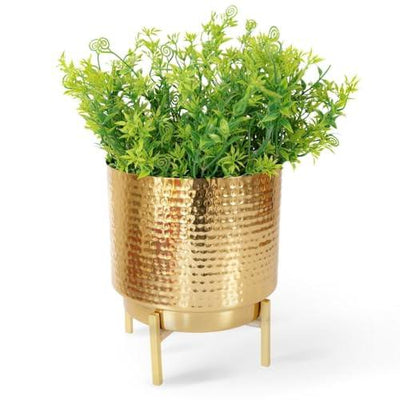ZZ Plants - Your Guide to Effortless Indoor Gardening
Introducing the ZZ Plant: The Unsung Hero of Houseplants
In the ever-evolving world of indoor gardening, there's one plant that has quietly stolen the hearts of plant enthusiasts everywhere - the ZZ Plant, also known as the Zanzibar Gem, Zee Zee Plant or Zamioculcas zamiifolia. This resilient and low-maintenance wonder has become a staple in homes and offices, offering a touch of lush greenery and a whole lot of personality.
If you're on the hunt for a plant that can thrive with minimal effort, the zee zee plant is your new best friend. With its striking, glossy foliage and ability to adapt to a wide range of conditions, it's no wonder this plant has become a favorite among both seasoned and novice plant parents.

In this comprehensive guide, we'll dive deep into the world of zanzibar gem plant, uncovering the secrets to their success and empowering you to become a master of indoor gardening. Get ready to unlock the full potential of this captivating plant and transform your living space into a verdant oasis.
zamioculcas zamiifolia care
Understanding the Allure of the ZZ Plant
The zee zee plant, scientifically known as Zamioculcas zamiifolia, is a true marvel of the plant kingdom. Originating from the arid regions of Africa, this hardy succulent has evolved to withstand a wide range of environmental conditions, making it an ideal choice for indoor settings.
One of the primary reasons the zee zee plant has gained such widespread popularity is its remarkable resilience. Unlike many other houseplants that require constant attention and care, the zee zee plant can thrive even in the face of neglect. Its thick, waxy leaves and robust root system allow it to store water, enabling it to survive extended periods of drought without wilting or losing its vibrant hue.
But the this plant's appeal goes beyond its low-maintenance nature. Its striking, architectural foliage, with its distinct, glossy green leaves, adds a touch of elegance and sophistication to any space. Whether you're decorating a cozy corner or brightening up a corporate office, the zanzibar gem plant presence is sure to make a bold statement.
Zamioculcas Zamiifolia care
Mastering the Ideal Growing Conditions for ZZ Plants
To ensure your zee zee plant thrives and reaches its full potential, it's essential to understand the specific growing conditions it requires. Let's dive into the key factors that will help your plant flourish:
Lighting Needs
zanzibar gem plant are true champions when it comes to adapting to various lighting conditions. They can tolerate a wide range of light levels, from bright, direct sunlight to low-light corners. However, for optimal growth and vibrant foliage, aim to provide your zee zee plant with bright, indirect light. Avoid placing it in direct, intense sunlight, as this can scorch the leaves.
Zamioculcas Zamiifolia care
Temperature and Humidity
zanzibar gem plant are quite adaptable when it comes to temperature. They can thrive in a range of 60°F to 85°F (15°C to 29°C), making them suitable for most indoor environments. Avoid exposing your plant to sudden temperature fluctuations or drafts, as this can cause stress and potentially lead to leaf damage.
As for humidity, ZZ Plants are relatively low-maintenance. They can tolerate average household humidity levels, so you don't need to worry about creating a specialized, humid environment for them.
Soil and Potting
When it comes to soil, zanzibar gem plant prefer well-draining, nutrient-rich potting mixes. Avoid heavy, dense soils that can lead to waterlogging and root rot. A well-aerated, slightly acidic soil with a pH between 6.0 and 6.5 is ideal. You can also mix in some perlite or sand to improve drainage.
As for potting, choose a container with ample drainage holes to prevent the soil from becoming oversaturated. When repotting, aim to do so every two to three years, or when the plant has outgrown its current pot.
Planting and Propagating zanzibar gem plant
Bringing home a new zee zee plant is an exciting step, and with the right planting techniques, you can ensure it thrives for years to come. Let's explore the process of planting and propagating these resilient beauties.
Zamioculcas Zamiifolia care
Planting Your zee zee plant
When planting your zee zee plant, start by selecting a well-draining pot that's slightly larger than the plant's root system. Gently remove the plant from its nursery container, being careful not to damage the roots. Place it in the new pot and fill the surrounding space with your well-draining potting mix, ensuring the soil level is slightly below the rim of the pot.
Water the plant thoroughly after planting, but be mindful not to overwater. zanzibar gem plant are susceptible to root rot, so it's crucial to allow the soil to dry out slightly between waterings.
Propagating ZZ Plants
One of the joys of owning a zanzibar gem plant is the ability to propagate it and share the love with friends and family. zanzibar gem plant can be propagated through stem cuttings or division, both of which are relatively straightforward processes.
For stem cuttings, simply snip off a healthy, mature stem, making sure to include a few leaves. Allow the cutting to dry out for a few days, then plant it in a well-draining potting mix. Keep the soil moist, and in a few weeks, you should see new growth emerging.
Alternatively, you can divide the plant's rhizomes (the horizontal, underground stems) when repotting. Carefully remove the plant from its pot and gently separate the rhizomes, ensuring each division has a few leaves and roots attached. Replant the divisions in individual pots, water them well, and watch as they establish themselves as new, thriving zanzibar gem plant.
Watering and Fertilizing Your ZZ Plant
Proper watering and fertilizing are crucial for the long-term health and vigor of your ZZ Plant. Let's explore the best practices to keep your plant happy and healthy.
Watering Techniques
ZZ Plants are known for their drought-tolerance, but that doesn't mean they can thrive without any water. The key is to find the right balance and avoid both over- and under-watering.
As a general rule, water your ZZ Plant when the top inch or two of the soil has dried out. This typically translates to watering every two to three weeks, depending on the environmental conditions. During the winter months, when the plant is in a more dormant state, you can reduce watering even further.
When watering, be sure to thoroughly soak the soil until it drains out the bottom of the pot. Avoid letting the plant sit in standing water, as this can lead to root rot.
Fertilizing Requirements
ZZ Plants are light feeders, so they don't require frequent fertilization. A balanced, water-soluble fertilizer applied every few months during the growing season (spring and summer) is typically sufficient.
When fertilizing, dilute the solution to half the recommended strength to avoid over-fertilizing, which can damage the plant. Avoid fertilizing during the winter months when the plant is in a dormant state.
Maintaining and Troubleshooting Your ZZ Plant
With the right care and attention, your ZZ Plant will thrive for years to come. Let's explore the essential maintenance tasks and address some common issues that may arise.
Pruning and Cleaning
ZZ Plants don't require frequent pruning, but you can trim off any dead or damaged leaves as needed. Use clean, sharp scissors or pruners to make clean cuts, and avoid tearing the leaves.
Regularly wiping down the leaves with a damp cloth can also help keep your ZZ Plant looking its best. This not only removes dust and debris but also helps the leaves absorb more light, promoting healthy growth.
Repotting Guidelines
As your ZZ Plant grows, it will eventually need to be repotted to accommodate its expanding root system. The best time to repot is in the spring, when the plant is actively growing.
When repotting, choose a pot that is only slightly larger than the previous one, as ZZ Plants prefer to be slightly root-bound. Gently remove the plant from its current pot, being careful not to damage the roots, and replant it in the new container with fresh, well-draining potting mix.
Troubleshooting Common Issues
While ZZ Plants are generally low-maintenance, they may occasionally encounter some common problems. Let's address a few of them:
Yellowing or Drooping Leaves: This can be a sign of overwatering or underwatering. Adjust your watering schedule accordingly and ensure the soil is draining properly.
Brown or Crispy Leaves: This is often a result of too much direct sunlight or low humidity. Move the plant to a spot with brighter, indirect light and consider misting the leaves occasionally.
Pests: these plant's are relatively resistant to pests, but they can occasionally attract spider mites or scale insects. Inspect the plant regularly and treat any infestations with a gentle, plant-safe insecticide.
Diseases: Root rot is the most common disease affecting this plant, typically caused by overwatering. If you notice the leaves wilting or the soil staying consistently moist, it's time to investigate the roots and potentially repot the plant in fresh, dry soil.
Decorating with ZZ Plants
The versatility of the ZZ Plant makes it an excellent choice for a wide range of indoor settings. Whether you're looking to add a touch of greenery to your home or office, these plants can seamlessly integrate into any decor.
Ideal Locations for zamioculcas zamiifolia
This plant thrive in a variety of locations, from bright, airy living rooms to dimly lit corners. They make excellent centerpieces on coffee tables, side tables, or shelves, and can also be used to flank entryways or line windowsills.
In the office, zamioculcas zamiifolia can help create a calming, natural atmosphere, whether placed on desks, credenzas, or reception areas. Their resilience and low-maintenance nature make them an ideal choice for corporate settings.
Styling and Combinations
The sleek, architectural foliage of the zamioculcas zamiifolia lends itself well to a variety of styling approaches. Consider pairing them with other low-maintenance succulents or air plants for a cohesive, modern look. You can also group multiple zamioculcas zamiifolia together for a lush, jungle-inspired vibe.
For a more minimalist aesthetic, showcase a single zamioculcas zamiifolia in a simple, modern planter. The plant's striking leaves will be the star of the show, drawing the eye and adding a touch of elegance to the space.
Exploring the Diverse World of Zamioculcas Zamiifolia Varieties
While the classic Zamioculcas zamiifolia is the most widely recognized this plant, there are several unique varieties that offer even more options for your indoor garden.
Common ZZ Plant Varieties
The standard green-leaved this plant is the most popular, but you can also find cultivars with variegated foliage, such as the 'Raven' or 'Zenzi' varieties. These offer a stunning contrast of dark, almost black leaves with bright green edges.
Another common variety is the 'Zamicro,' a compact, dwarf version of the ZZ Plant that's perfect for smaller spaces or terrariums.
Rare and Unique Cultivars
For the true plant enthusiast, there are some rare and unique ZZ Plant cultivars to explore. The 'Dowon' variety features striking, deeply lobed leaves, while the 'Zenzi' boasts a more compact, bushy growth habit.
If you're feeling adventurous, keep an eye out for the 'Raven' ZZ Plant, which showcases stunning, almost black foliage that adds a dramatic touch to any space.
No matter which ZZ Plant variety you choose, you're sure to be rewarded with a low-maintenance, eye-catching addition to your indoor garden.
Conclusion: Embrace the Power of the This plant
The ZZ Plant is a true marvel of the plant kingdom, offering a unique combination of resilience, beauty, and versatility. Whether you're a seasoned plant parent or just starting your indoor gardening journey, this plant is a must-have for any space.
By following the tips and techniques outlined in this comprehensive guide, you'll be well on your way to cultivating a thriving Plant that will bring joy and life to your home or office for years to come. Embrace the power of this unsung hero and let it transform your living space into a verdant oasis of tranquility.
So, what are you waiting for? Bring home a ZZ Plant today and unlock the secrets to effortless indoor gardening. Your journey to becoming a ZZ Plant master begins now!

















Leave a comment